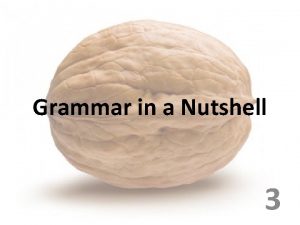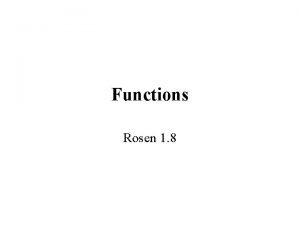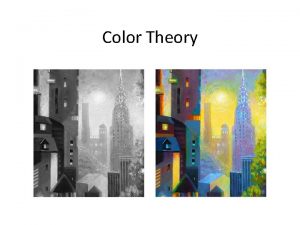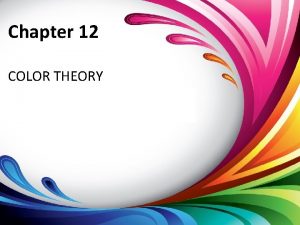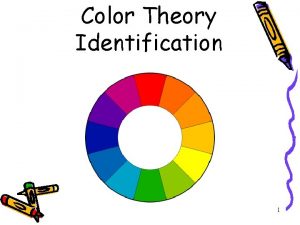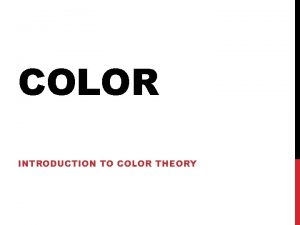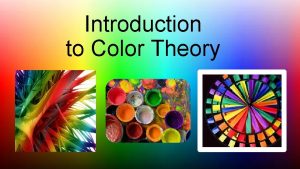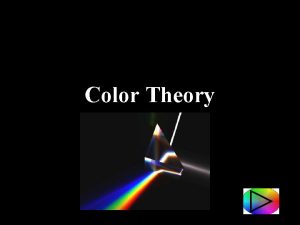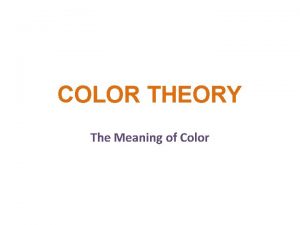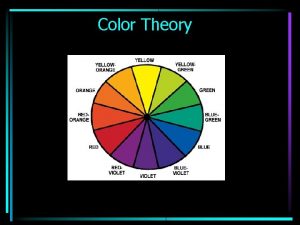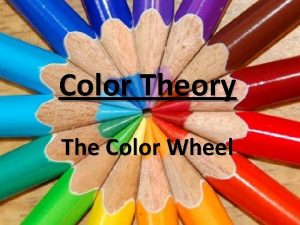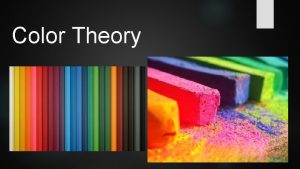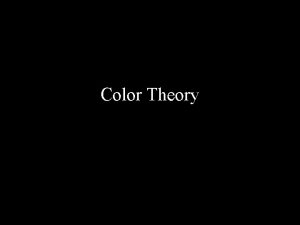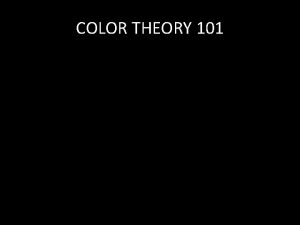An Introduction to COLOR THEORY Color is one

























- Slides: 25

An Introduction to COLOR THEORY

Color is one of the most expressive elements because its quality affects our emotions directly and immediately. - In representational art, color serves to identify objects and to create the effect of illusionistic space Janet Fish Orange Bowl and Yellow Apples 1980, Oil on canvas

Red, Yellow & Blue

Roy LICHTENSTEIN (1923 -1997) Untitled 1974 Silkscreen 82/100 113 cm x 90 cm Tehran Museum of Contemporary Art Primary color scheme

When you mix a primary color with a primary color next to it on the color wheel you get a secondary color. Blue+Red=Violet Yellow+Blue=Green Red+Yellow=Orange

Tertiary/ Intermediate Colors are made by mixing the primary & secondary colors next to each other on the color wheel.

Tints are lightened colors. Always begin with white and add a bit of color to the white until the desired tint is obtained. This is an example of a value scale for the tints of blue.

Shades are darkened colors. Always begin with the color and add just a bit of black at a time to get the desired shade of a color. This is an example of a value scale for the shades of blue.

Warm and cool color schemes Cool colors Warm colors

Warm color scheme Atmospheric conditioning Neutralized colors The Wolf River, Kansas Albert Bierstadt c. 1859 Oil on canvas 48 1/8 x 38 1/8 inches (122. 5 x 97. 1 cm) The Detroit Institute of Arts, Detroit, USA

Monochromatic color schemeone color and it’s tints and shades. Cool color scheme Pablo Picasso, The Tragedy, 1903, oil on wood, 1. 053 x. 690 m (41 7/16 x 27 3/16 in. ), National Gallery of Art, Washington, Color evokes mood

Analogous Colors – colors that have ‘neighboring’ hues, contain one common color from the color wheel.

Complementary Color scheme Complementary colors: colors opposite each Andy Warhol Elvis I and II 1964 silkscreen on acrylic, on aluminum 208. 3 x 208. 3 cm other on the color wheel Red/Green Orange/Blue Yellow/Violet

Split Complementary A split complementary color scheme is made up of three colors. One color and the two neighboring colors to it’s complement.

Monochromatic A monochromatic color scheme is when you only use one color or hue and all the different tints and shades of that color.

The importance of dulling (neutralizing) color Neutralized color - color intensity is neutralized by adding its complement or a neutral color, white, black or grey.

Warm or cool color scheme? Analogous or complementary color schemes? Paul Cezanne 1839 -1906 Landscape, 1900 Oil on canvas h 62. 2 cm , w 51. 5 cm

Pattern and Repetition Pattern is a repeated design Repetition is the repeating of an occurrence, or form

Color as you see it Henri Fantin-Latour French, 1836 - 1904 Still Life, 1866 oil on canvas, 62 x 74. 8 cm (24 3/8 x 29 1/2 in. ) National Gallery of Art, Washington

Expressive color Marie Laurencin, 1925 Mother and child Oil on canvas Subjective colors are when the colors do not represent the actual local color.

Actual or expressive color? Poplars on the Banks of the River Epte, Sunset Claude Monet, 1891 The Athenaeum

Michelangelo Merisi called Caravaggio Madonna dei Palafrenieri (1605) oil on canvas cm. 2, 92 x 2, 11 Borghese Gallery Light intensity - a color appears lighter when the color around it is darker

Georges Seurat French, 1859 -1891 A Sunday on La Grande Jatte— 1884 Oil on canvas 207. 5 x 308 cm Optical color mixtures are when the artist depends on the eye to mix the colors.

Optical color mixture Local color? Complementary color scheme? Chuck Close Lyle, 2002 Chuck Close (American, born 1940) 147 -color silk screen 65 1/2 x 53 7/8 in. Edition of 80

Henri Matisse: Portrait of Madame Matisse. The Green Line, 1905. 40, 50 x 32, 5 cm Oil on canvas What are the color relationships in Matisse’s painting of Madame Matisse?
 One god one empire one religion
One god one empire one religion One one one little puppy run
One one one little puppy run One king one law one faith
One king one law one faith Byzantine definition
Byzantine definition One ford plan
One ford plan See one do one teach one
See one do one teach one One price policy
One price policy One face one voice one habit and two persons
One face one voice one habit and two persons Studiendekanat uni bonn
Studiendekanat uni bonn One vision one identity one community
One vision one identity one community Asean one vision one identity one community
Asean one vision one identity one community Introduction paragraph format
Introduction paragraph format Sap business one introduction
Sap business one introduction Sin entered through one man
Sin entered through one man Songs with poetic techniques
Songs with poetic techniques How much is 30 tens
How much is 30 tens Othello summary act 1 scene 1
Othello summary act 1 scene 1 One team one mission meaning
One team one mission meaning One goal one passion
One goal one passion One gene one polypeptide
One gene one polypeptide Jean watson caring moment
Jean watson caring moment One voice one look
One voice one look Many species one planet one future
Many species one planet one future One of ones
One of ones Find the inverse of function f. a. b. c. d.
Find the inverse of function f. a. b. c. d. Contoh erd many to many
Contoh erd many to many























